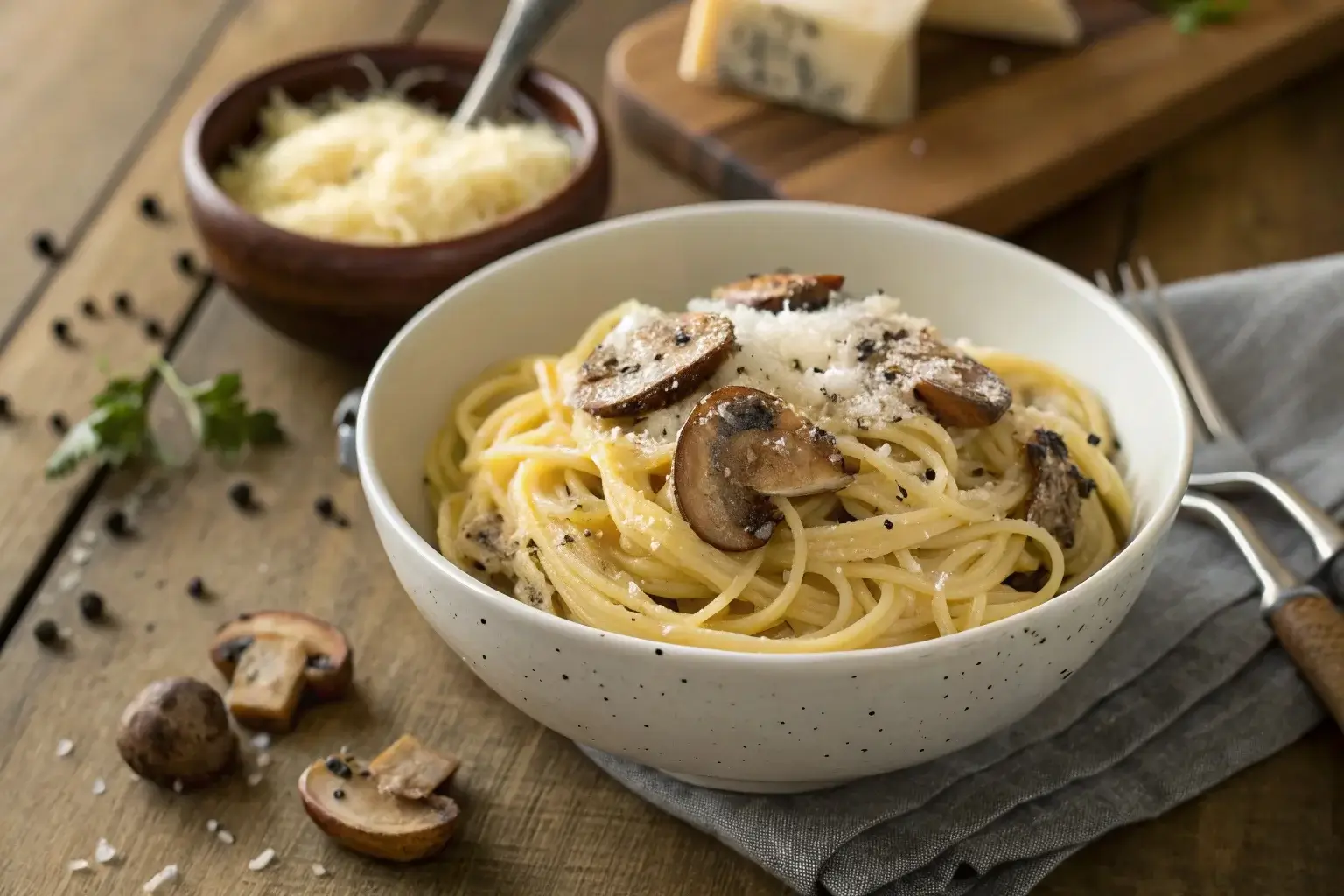When it comes to comfort food, few dishes rival the creamy, savory magic of spaghetti carbonara. Traditionally made with eggs, cheese, and bacon, this Roman classic has been adapted into a delicious meat-free version: vegetarian spaghetti carbonara. With the right ingredients and techniques, you can create a dish that’s just as indulgent as the original, minus the meat. From mushrooms and smoked paprika to plant-based bacon alternatives, this version promises rich umami flavors that will leave you craving more. In this article, you’ll learn everything from essential ingredients and step-by-step instructions to creative twists and pairing suggestions.
My first attempt at making vegetarian spaghetti carbonara with my husband, Momo, was both fun and chaotic. We had just discovered this recipe during a late-night search for meat-free dinner ideas, and I couldn’t wait to give it a shot. Momo was in charge of prepping the mushrooms while I whisked together the egg mixture. Let’s just say, we learned a lot that evening—like how adding the eggs too quickly can lead to scrambled carbonara! But we laughed through the mishaps, and by the time we sat down to eat, the aroma of garlic, black pepper, and parmesan filled the kitchen. That first bite was pure bliss, and we’ve been perfecting it ever since.
Table of Contents
Introduction to Vegetarian Spaghetti Carbonara
Overview of the Classic Carbonara and Its Vegetarian Twist
Spaghetti carbonara is a Roman classic known for its simplicity and rich, creamy flavor. The traditional version uses just a few ingredients: spaghetti, guanciale (pork), eggs, Pecorino Romano, and black pepper. However, the rise of plant-based diets has inspired creative adaptations of this dish, and vegetarian spaghetti carbonara has become a favorite among those seeking meat-free alternatives without compromising taste.
Why Meat-Free Carbonara Has Gained Popularity
With more people looking for plant-based options, vegetarian carbonara offers a guilt-free indulgence. Mushrooms, smoked tofu, or veggie bacon are commonly used to replicate the smoky, salty notes of guanciale. Paired with garlic, black pepper, and parmesan (or vegetarian substitutes), the dish delivers the same satisfying bite as the original, making it popular among vegetarians and even meat lovers curious to try something new.
What You’ll Learn in This Guide
This guide will walk you through the key ingredients, step-by-step instructions, variations, and pairing suggestions to help you master the perfect vegetarian spaghetti carbonara. Whether you’re a seasoned cook or new to the kitchen, you’ll be whipping up this creamy dish in no time.
What Makes Vegetarian Spaghetti Carbonara Unique?
Creating a delicious plate of vegetarian spaghetti carbonara means reimagining the flavors of the classic dish using plant-based ingredients while keeping the creamy texture and smoky flavor we all love. The absence of guanciale or pancetta isn’t a limitation—it’s an opportunity to experiment with equally savory substitutes.
Key Differences Between Traditional and Vegetarian Carbonara
Traditional carbonara relies on cured pork to give the dish its signature saltiness and umami taste. However, vegetarian spaghetti carbonara swaps out meat for flavorful alternatives like sautéed mushrooms, smoked tofu, or plant-based bacon. These options create a smoky, rich flavor profile, while retaining the essence of the dish. Additionally, traditional recipes typically use Pecorino Romano cheese, but vegetarians may choose Parmesan or a non-dairy cheese substitute to fit their dietary needs.
Using Umami-Rich Ingredients to Enhance Flavor
To ensure the vegetarian version doesn’t miss out on that deep umami kick, ingredients like garlic, smoked paprika, nutritional yeast, and sun-dried tomatoes come into play. For instance, mushrooms (especially shiitake or portobello) can be sautéed in olive oil with garlic until caramelized, mimicking the meaty bite of pork. Smoked paprika or liquid smoke adds an extra layer of flavor, elevating the dish without overpowering its creamy texture.
This simple yet effective combination of ingredients ensures that vegetarian spaghetti carbonara delivers the same mouthwatering satisfaction as its traditional counterpart.
Essential Ingredients for the Best Vegetarian Spaghetti Carbonara
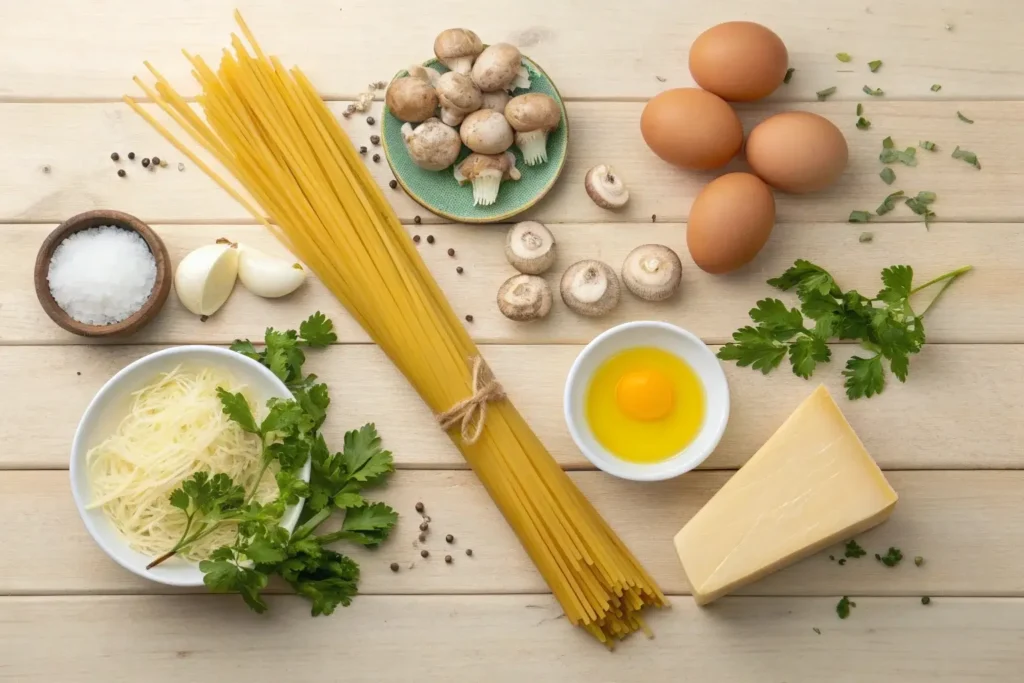
Pasta Selection: Choose the Right Base
The foundation of any great carbonara is the pasta. Spaghetti is the classic choice due to its long, thin strands that evenly coat with the creamy sauce. For those seeking a healthier or gluten-free option, chickpea or brown rice pasta are excellent alternatives. Just be sure to cook it al dente to maintain a slightly firm texture, as overcooked pasta can affect the dish’s overall consistency.
Eggs, Parmesan, and Black Pepper
The combination of eggs, cheese, and black pepper is what defines the sauce of a carbonara. For the vegetarian version, use fresh eggs and high-quality Parmesan cheese, or opt for vegetarian-approved Parmesans or nutritional yeast for a vegan twist. Black pepper is more than a seasoning here—it’s an essential flavor booster that complements the richness of the sauce.
Flavor-Enhancers: Mushrooms, Garlic, and Plant-Based Proteins
Sautéed mushrooms add depth and a meaty texture, making them a key ingredient in vegetarian spaghetti carbonara. Garlic, another staple, infuses the dish with its aromatic richness. For those wanting a protein boost, smoked tofu or plant-based bacon crumbles can be added to enhance both the flavor and nutrition of the dish.
Olive Oil or Plant-Based Butter for Creaminess
Instead of relying solely on eggs, a drizzle of olive oil or plant-based butter can help achieve a luscious, velvety sauce. This step ensures the pasta remains moist and flavorful throughout every bite.
Step-by-Step Guide to Making Vegetarian Spaghetti Carbonara
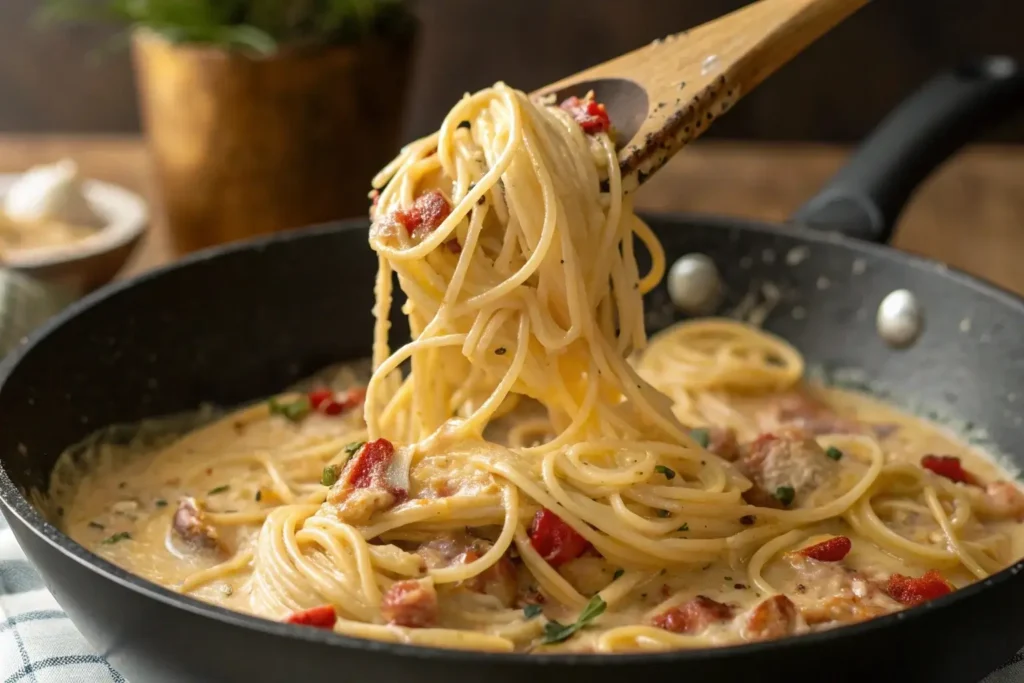
Making vegetarian spaghetti carbonara is all about timing, technique, and the right blend of ingredients. Follow this step-by-step guide to create a creamy, satisfying dish that rivals the classic version.
Step 1: Preparing and Cooking the Spaghetti
Start by boiling a large pot of salted water. The salt will help flavor the pasta and enhance the overall dish. Add your spaghetti and cook it until al dente, as overcooked pasta will become mushy when combined with the sauce. Reserve about a cup of pasta water before draining—it’s essential for creating the creamy sauce later.
Step 2: Sautéing the Flavor Base
While the pasta cooks, heat olive oil in a large pan over medium heat. Add diced mushrooms, garlic, and a pinch of salt. Sauté until the mushrooms release their moisture and caramelize, which gives them a meaty texture and deep flavor. If you’re using plant-based bacon or smoked tofu, add them at this stage and cook until golden and slightly crisp. The combination of garlic and mushrooms will lay the foundation for the dish’s smoky, savory taste.
Step 3: Whisking the Egg Mixture
In a bowl, whisk together eggs, grated Parmesan cheese (or a vegetarian substitute), and a generous amount of black pepper. The mixture should be smooth and well combined. This step is crucial to ensure that the eggs coat the pasta evenly without curdling.
Step 4: Tossing Everything Together
Once the pasta is ready, add it directly to the pan with the mushrooms and garlic. Turn off the heat to prevent the eggs from scrambling. Slowly pour the egg mixture over the pasta while tossing continuously. Gradually add some reserved pasta water, one tablespoon at a time, until the sauce reaches your desired creaminess. The heat from the pasta will cook the eggs gently, creating a velvety sauce that clings to every strand.
Step 5: Final Touches
Taste and adjust the seasoning with salt and pepper, if needed. For extra depth, sprinkle a little more Parmesan on top and garnish with fresh parsley or basil. Serve immediately for the best texture and flavor.
Common Variations and Creative Twists
One of the best things about vegetarian spaghetti carbonara is how easily it can be customized. Whether you’re looking for a lighter version, a vegan option, or a creative twist, there’s a variation to fit every taste.
Creamy Avocado Carbonara for a Dairy-Free Option
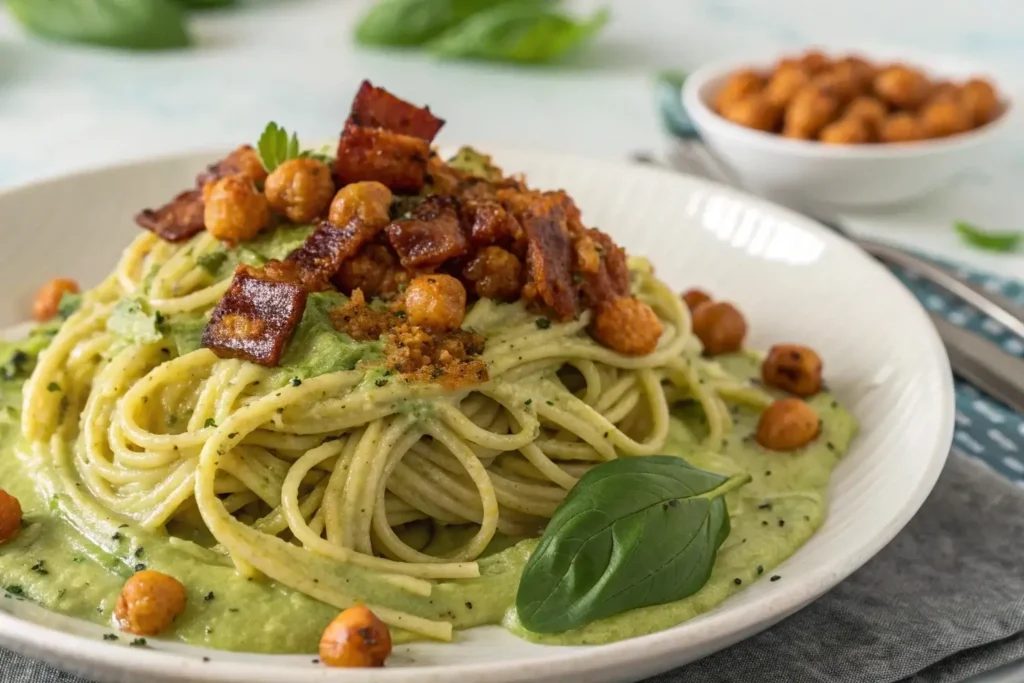
For those avoiding dairy, creamy avocado is the perfect substitute. Blend ripe avocado with garlic, lemon juice, nutritional yeast, and olive oil to create a smooth, velvety sauce. Toss this mixture with your spaghetti and top it with sautéed mushrooms for a rich, plant-based alternative.
Vegan Carbonara with Nutritional Yeast and Chickpea Flour
To make a completely vegan version, replace eggs with chickpea flour and water or silken tofu to achieve a thick sauce. Nutritional yeast, with its cheesy flavor, is a great substitute for Parmesan. Adding a dash of smoked paprika or liquid smoke enhances the umami profile without any animal products.
Greens and Veggie Additions
Add a burst of freshness and color by tossing in vegetables like spinach, kale, or zucchini ribbons. They pair well with the creamy sauce and add nutrients, making the dish both hearty and healthy.
Using Different Pasta Shapes
Who says carbonara is limited to spaghetti? Try using fettuccine, penne, or even orecchiette to change up the texture and presentation. The sauce clings just as well to these shapes, giving you a new experience with every bite.
No matter the variation, vegetarian spaghetti carbonara remains a versatile dish, perfect for any occasion. (For more pasta inspiration, check out this Crockpot Spaghetti Sauce Recipe for a slow-cooked option that pairs wonderfully with carbonara.)
Nutritional Benefits and Health Considerations
While vegetarian spaghetti carbonara is known for its indulgent, creamy texture, it can also be surprisingly nutritious when made with the right ingredients. From plant-based proteins to heart-healthy fats, this meat-free version offers several health benefits.
Protein and Fiber from Plant-Based Ingredients
Mushrooms, smoked tofu, and plant-based bacon are excellent protein sources that can rival the meat content of traditional carbonara. These plant-based options help build muscle and keep you full for longer. Whole grain or legume-based pasta, such as chickpea spaghetti, adds fiber, promoting digestion and maintaining steady energy levels.
Lower Saturated Fat Compared to Traditional Carbonara
One major advantage of vegetarian spaghetti carbonara is its reduced saturated fat content. Replacing guanciale or pancetta with mushrooms or tofu significantly cuts down on unhealthy fats, making this version a heart-friendlier option. Even if you’re using eggs and cheese, opting for light versions or vegetarian substitutes keeps the dish balanced without sacrificing flavor.
Lightening Up the Dish
For those seeking a lower-calorie meal, using zucchini noodles or shirataki noodles instead of traditional pasta is a great option. Olive oil or avocado can replace heavy cream or butter, providing healthy fats while maintaining a creamy consistency. To boost nutritional content further, toss in leafy greens like spinach or kale for added vitamins and antioxidants.
With these small adjustments, vegetarian spaghetti carbonara can be both a comfort food and a wholesome meal.
Tips for Making Perfect Vegetarian Spaghetti Carbonara
Tips for Amateur Cooks
- Start Simple: Stick to basic ingredients like mushrooms, garlic, eggs, and Parmesan for your first attempt. Once you’re comfortable, you can experiment with variations.
- Use Reserved Pasta Water: Don’t forget to save pasta water, as it’s key to achieving a smooth and creamy sauce.
- Remove the Pan from Heat Before Adding Eggs: This prevents the eggs from scrambling, ensuring a velvety sauce.
- Taste as You Go: Always taste the sauce before serving to adjust seasoning. A little extra pepper or cheese can go a long way!
Tips for Advanced Cooks
- Make Your Own Plant-Based Bacon: If you’re up for a challenge, try marinating and baking your own veggie bacon using tempeh or mushrooms with smoked paprika.
- Infuse the Oil with Flavor: Sauté garlic and chili flakes in olive oil before adding mushrooms for an extra flavor boost.
- Try Homemade Pasta: For a gourmet experience, make your own fresh pasta. It holds the sauce better and adds a chewy, satisfying texture.
- Experiment with Garnishes: Fresh herbs, lemon zest, or even toasted breadcrumbs can elevate your carbonara to restaurant-level quality.
Whether you’re a beginner or an experienced cook, these tips will help you master vegetarian spaghetti carbonara and impress anyone you serve it to!
Pairing Suggestions and Serving Tips
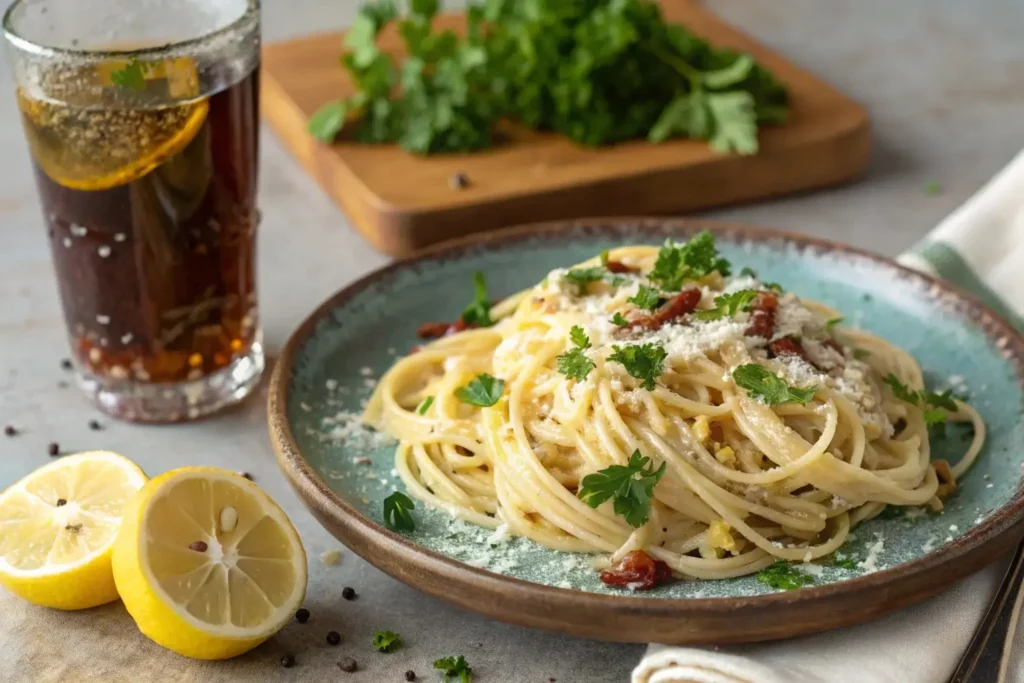
Pairing your vegetarian spaghetti carbonara with the right sides and beverages can take your meal to the next level. Here’s how to enhance the dining experience with complementary dishes and garnishes.
Side Dishes to Serve with Carbonara
- Garlic Bread: Warm, crusty garlic bread is the ultimate sidekick, soaking up the rich, creamy sauce. You can opt for a gluten-free version if needed.
- Caesar Salad: A crisp Caesar salad with crunchy croutons and a zesty dressing balances the richness of the carbonara. For a vegetarian twist, replace anchovies with capers in the dressing.
- Roasted Vegetables: Oven-roasted asparagus, broccoli, or Brussels sprouts add a burst of earthy flavors that pair beautifully with the pasta.
Wine Pairings and Drinks
For wine lovers, a glass of crisp white wine, such as Sauvignon Blanc or Pinot Grigio, complements the creamy sauce without overpowering it. For a non-alcoholic option, try sparkling water with lemon or iced herbal tea to cleanse the palate.
Garnishing Ideas
Top your vegetarian spaghetti carbonara with freshly grated Parmesan or nutritional yeast, a sprinkle of cracked black pepper, and fresh parsley or basil for a pop of color and flavor. A zest of lemon can also add brightness, cutting through the richness of the dish.
With the right sides and pairings, your carbonara dinner can become a complete, satisfying meal for any occasion.
Storage and Reheating Tips for Vegetarian Spaghetti Carbonara
Proper storage and reheating techniques are essential to preserving the creamy texture and bold flavors of vegetarian spaghetti carbonara. Without careful handling, the sauce can become clumpy, and the pasta may dry out. Follow these tips to enjoy your leftovers without compromising taste.
Storing Leftovers the Right Way
- Let It Cool Completely: Before storing, allow the carbonara to cool to room temperature. This prevents condensation, which can make the pasta soggy.
- Use an Airtight Container: Transfer the pasta to an airtight container and refrigerate it. Properly stored, it will stay fresh for up to 3 days.
- Freezing Tips: If you plan to freeze it, portion the pasta into smaller servings and store it in freezer-safe containers. This prevents thawing large batches at once. Frozen vegetarian spaghetti carbonara can last up to 2 months, though freshly cooked pasta is always best.
Reheating Without Curdling the Sauce
- Stovetop Method: For the best results, reheat the pasta gently on the stovetop over low heat. Add a splash of water, vegetable broth, or plant-based milk to loosen the sauce as it warms. Stir continuously to prevent clumping.
- Avoid the Microwave: Microwaving can lead to scrambled eggs in the sauce. If you must use the microwave, heat it in short bursts and stir frequently.
- Revive the Flavors: Once heated, sprinkle fresh Parmesan or nutritional yeast on top, along with a dash of black pepper, to restore the original taste.
Following these storage and reheating tips will help your vegetarian spaghetti carbonara maintain its creamy, satisfying texture—even after a day or two in the fridge.
Frequently Asked Questions (FAQ)
Here are answers to common questions about making the perfect vegetarian spaghetti carbonara:
1. Can you make vegetarian spaghetti carbonara without eggs?
Yes, you can! For a vegan alternative, replace eggs with silken tofu, chickpea flour, or cashew cream. These substitutes help achieve the creamy texture while keeping the dish egg-free.
2. What’s the best plant-based substitute for bacon in carbonara?
Sautéed mushrooms, smoked tofu, and plant-based bacon are popular choices. Shiitake mushrooms provide a chewy texture, while smoked tofu or tempeh offers a protein boost with a smoky flavor.
3. How do you prevent scrambled eggs in carbonara sauce?
The key is to remove the pan from heat before adding the egg mixture. Toss the pasta continuously to allow the residual heat to cook the eggs gently, creating a smooth, creamy sauce without curdling.
4. Can you make the dish ahead of time and reheat it later?
While carbonara is best served fresh, you can make it ahead and store it in the fridge for up to 3 days. Follow proper reheating instructions to maintain the creamy consistency.
Why You Should Try Vegetarian Spaghetti Carbonara Today
Vegetarian spaghetti carbonara is proof that you don’t need meat to enjoy a rich, flavorful, and satisfying meal. With its creamy sauce, smoky plant-based ingredients, and savory flavor profile, this dish can easily become a favorite for vegetarians and non-vegetarians alike. Whether you prefer mushrooms, tofu, or veggie bacon as your protein source, the flexibility of this recipe allows you to customize it to your taste.
Beyond its taste, this version of carbonara offers health benefits, from reduced saturated fat to plant-based proteins. It’s perfect for anyone seeking a lighter, wholesome alternative to the traditional dish. Plus, the simple ingredients and quick preparation make it ideal for weeknight dinners or cozy weekend meals.
By experimenting with different pasta shapes, sauces, and garnishes, you can create endless variations to suit any occasion. So, why not give it a try today? Your taste buds will thank you!
